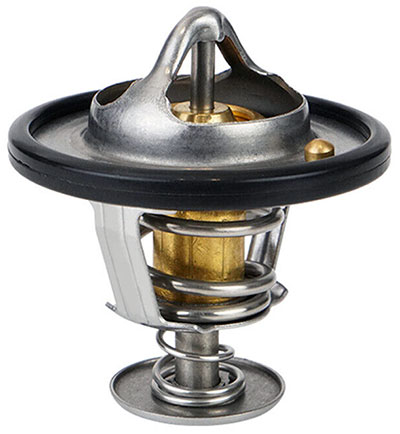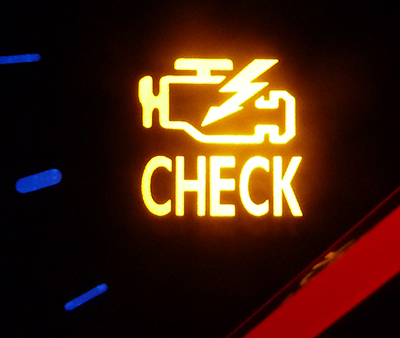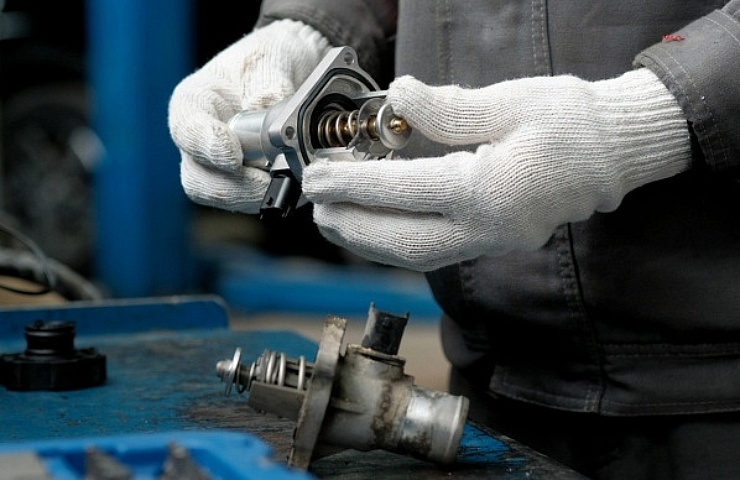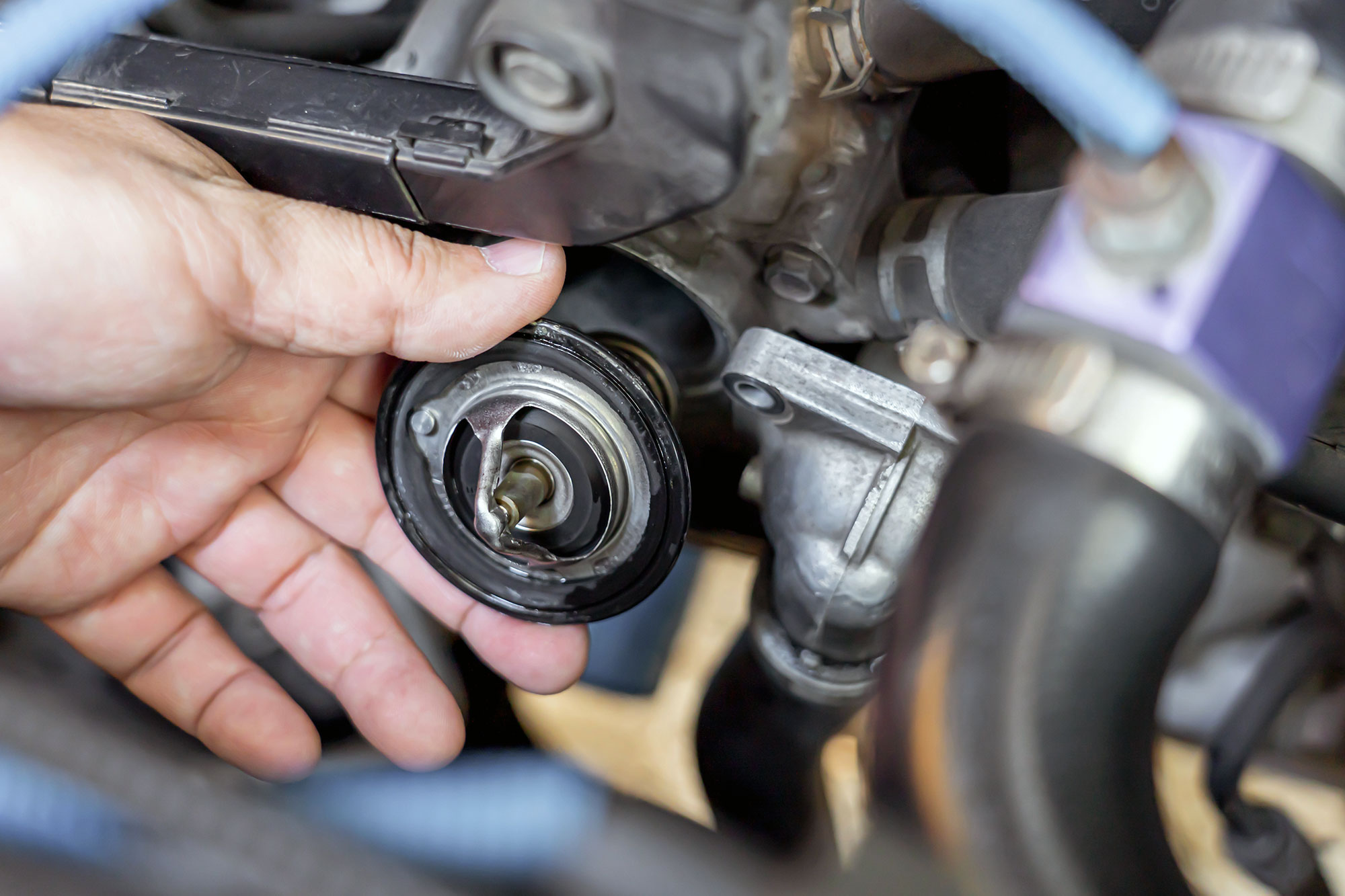Contents
What Is a Thermostat?

Toyota engine coolant thermostat
Your car’s thermostat looks like a round peg with a spring surrounding it. It has a flat top and can easily fit in the palm of your hand.
The thermostat’s most important function is to prevent the engine from overheating. Also, the thermostat—using the vehicle’s HVAC system—optimizes the ambient conditions inside the cabin by helping to distribute warm air.
The thermostat is easy to find. Most of the time, it is mounted close to the water pump on the cylinder head. Locate your top radiator hose and follow it to the end, where it connects to the water pump or cylinder head. In some vehicles, the thermostat housing is located on the lower radiator hose.
How the Thermostat Works
Initially, the thermostat valve is closed, allowing the engine to heat up by blocking the coolant’s flow through the radiator.
The thermostat valve opens fully after the engine heats to between 190 and 210 degrees Fahrenheit. This allows hot coolant to begin flowing from the engine into the radiator, where it will cool. As the coolant temperature falls to the lower end of the optimum temperature range, the thermostat closes again to allow the engine to heat up.
This cycle continues to run while the engine is running. If the engine is too cold, it won’t operate as intended. If it’s too hot, the engine could overheat. In either situation, the thermostat could be faulty and might need to be replaced.
Symptoms of a Faulty Thermostat

In relatively new vehicles, the car’s computer monitors the thermostat. If the thermostat is stuck, the check engine light will come on. Mechanics with an infrared thermometer can measure the temperature of the upper and lower radiator hoses.
- If the thermostat is stuck shut, the upper hose will read hotter temperatures than the lower hose.
- If the thermostat is stuck open, the lower hose will start warming up as soon as the engine starts.
The following symptoms could also indicate a faulty thermostat:
Engine temperature fluctuations – It’s a problem if the thermostat sends mixed signals to the engine temperature gauge. The readings could swing back and forth from high to low.
Heater fluctuations – Your car’s temperature gauge and the air from the heater in the cabin fluctuate between hot and cold.
Steam from under the hood – If the thermostat is stuck shut, the engine temperature will rise, creating high pressure as the coolant boils. If the pressure gets too high, it can cause the coolant to leak from a gasket or blow a hole in the radiator hose. That leads to steam from the hood or the smell of coolant coming through the heater vents.
Leaking coolant – A safety feature on your vehicle’s engine dumps coolant out of an overflow valve on the radiator if it gets too hot. If the thermostat is stuck closed and the engine overheats, the overflow will release coolant directly on the ground under the vehicle.
Shop now for auto thermostatsHow to Fix a Faulty Thermostat
Thermostat replacement is usually easy enough for do-it-yourselfers with basic mechanical skills. From start to finish, it should take about one hour.
Here is a list of equipment you’ll need for the job:
- New thermostat
- Thermostat gasket
- Coolant/antifreeze
- Jack
- Jack stands
- Drain pan
- Ratchet and socket set
- Pliers and screwdriver
- Gloves
- Shop towels
- Car radiator flush (optional)
Step-by-Step Installation
- Ensure the engine is completely cooled down, then open the hood and inspect the coolant/antifreeze. If it looks dirty or rusty, flush the radiator thoroughly.
- Depending on the vehicle and the thermostat’s location, you might need to jack the car’s front end and secure the jack stands in place.
- Place the drain pan under the engine.
- Open the drain valve or remove the lower radiator hose and the cap. If you are replacing the coolant, recycle it properly. If not, store it carefully to refill it once the job is complete.
- Follow the radiator hose to the engine, disconnect the radiator hose clamp, and pull the hose off.
- Remove the metal thermostat housing and cover bolts, then remove the housing. Some newer vehicles use a combined thermostat housing.
- Take note of the thermostat’s orientation and photograph it with your phone so you can properly mount and install the new thermostat. Compare the new and old thermostats to ensure you purchased the correct part.
- Remove the old thermostat and thoroughly clean the metal surface of the housing to remove all residue from the old gasket.
- Install the new thermostat gasket and ensure the alignment is correct.
- Insert the new thermostat into the engine in the same position as the old one. The deeper spring side goes down into the engine, with the shorter end sitting in the housing. There may be a tab on the thermostat. If so, it goes through a slot in the thermostat flange. If the thermostat doesn’t sit flat, it’s not installed properly.
- Replace the thermostat housing using the existing housing bolts and secure it to 15 pound-feet of torque. If you don’t have a torque wrench, it’s about the same force needed to twist open a bottle cap.
- Securely reattach the radiator hoses and hose clamps.
- Be sure the radiator drain valve is closed and lower the vehicle.
- Refill the cooling system with either new or recycled coolant.
- Start the engine and monitor the coolant level, watching that air bubbles are getting out. Run the engine for about 10 minutes with the car’s heater on. Replace the radiator cap after all the bubbles are gone and the radiator is full.
- Take the car for a drive, paying attention to the engine temperature. After a day or two of driving, check the coolant level in the plastic reservoir and bring it up to its proper level as indicated on the reservoir if needed.
It’s not always necessary to drain the coolant to change the thermostat. If the old thermostat is positioned at the bottom of the radiator, you have no choice because all the coolant will drain by itself.
If you drive with a bad thermostat, your car could overheat, causing severe and expensive engine damage. And while it’s technically possible to drive without a thermostat, we don’t recommend it. Your car will not reach an acceptable operating temperature, resulting in higher fuel consumption and excessive engine wear.
Shop now for auto thermostats






